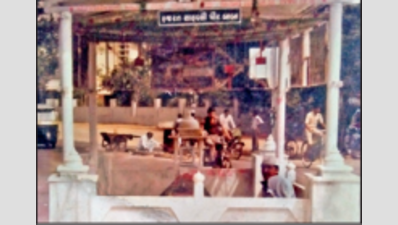- News
- City News
- ahmedabad News
- Wali Gujarati rises from razed grave, enters textbook
Trending
This story is from May 4, 2016
Wali Gujarati rises from razed grave, enters textbook
Wali's grave, which was located opposite the Police Stadium in Shahibaug, was destroyed on February 28 evening in the riots that engulfed Gujarat.Overnight, tar was spread on the grave site.

Wali's grave, which was located opposite the Police Stadium in Shahibaug, was destroyed on February 28 evening in the riots that engulfed Gujarat.Overnight, tar was spread on the grave site.
AHMEDABAD: India's father of Urdu ghazal, Wali Gujarati, whose almost 300-year-old grave was razed by rioting mobs in the 2002 post-Godhra riots - never to be rebuilt - is now getting space in the new class 11 Hindi textbook published by the Gujarat State School Textbook Board.
Wali's grave, which was located opposite the Police Stadium in Shahibaug, was destroyed on February 28 evening in riots that engulfed Gujarat.Overnight, tar was spread on the grave site. Later, desperate attempts to rebuild the grave never bore fruit. Even today, the remnants of the Wali's grave remain beneath the road divider where a few devoted fans still offer flowers every day.
It is surprising then that this poet has found some space in the pages of school textbooks. "Gujarat ke firaq se hai khaar khaar dil, Betaab hai seenay mein atish bahar dil, Marham nahin hai iske zakhm ka jahan mein, Shamshir e hijr se jo hua hai figar dil" (My heart is thorn-filled with longing for Gujarat; restless, frantic, flame-wrapped in the spring; on earth there exists no balm for this wound; my heart is split asunder by the dagger of separation). This foregoing ghazal written by Wali depicted his sorrow as he left Gujarat for Delhi. It has been included in the class 11 Hindi (first language) textbook.
The introductory text explains that the 17th century Urdu poet loved Gujarat and longed to return to his beloved state. It is believed that he returned to Ahmedabad where he breathed his last. There is no reference however to the hatred which demolished Wali's grave.
A lesson on Shastri titled 'Tapasvi Sarasvat' (scholar saint) is written by Kheda-based Chandrakant Sheth. The lesson outlines the educational qualifications and scholarship of Shastri and his contribution to the Gujarati language, but does not comment on his ideology.
Nitin Pethani, the executive president of the Gujarat State School Textbook Board, said that the board has for the first time included K K Shastri and Wali Gujarati in the textbooks.
Other Gujarat notables included in the textbooks comprise figures like the erstwhile king of Bhavnagar, Maharaja Krushnkumarsinh (social science book of class 9, Gujarati medium); theatre and film personality Upendra Trivedi (Gujarati textbook for English-medium students of class 9); Dena bank founder Nanji Kalidas (first-language textbook for Gujarati-medium students of class 9); and Bhartiya Jan Sangh founder Deendayal Upadhyay (economics textbook for class 11). Besides, renowned tribal leader Birsa Munda (first-language textbook for class 11 Hindi medium), athlete P T Usha (first-language textbook for English medium) and former President A P J Abdul Kalam (class 9 and 11 English language textbooks) have also been included, said Pethani.
Wali's grave, which was located opposite the Police Stadium in Shahibaug, was destroyed on February 28 evening in riots that engulfed Gujarat.Overnight, tar was spread on the grave site. Later, desperate attempts to rebuild the grave never bore fruit. Even today, the remnants of the Wali's grave remain beneath the road divider where a few devoted fans still offer flowers every day.
It is surprising then that this poet has found some space in the pages of school textbooks. "Gujarat ke firaq se hai khaar khaar dil, Betaab hai seenay mein atish bahar dil, Marham nahin hai iske zakhm ka jahan mein, Shamshir e hijr se jo hua hai figar dil" (My heart is thorn-filled with longing for Gujarat; restless, frantic, flame-wrapped in the spring; on earth there exists no balm for this wound; my heart is split asunder by the dagger of separation). This foregoing ghazal written by Wali depicted his sorrow as he left Gujarat for Delhi. It has been included in the class 11 Hindi (first language) textbook.
The introductory text explains that the 17th century Urdu poet loved Gujarat and longed to return to his beloved state. It is believed that he returned to Ahmedabad where he breathed his last. There is no reference however to the hatred which demolished Wali's grave.
Wali shares space with K K Shastri, popularly referred to as 'Keka' Shastri, the founding leader of the Vishwa Hindu Parishad, which is among the right-wing groups allegedly involved in the riots.
A lesson on Shastri titled 'Tapasvi Sarasvat' (scholar saint) is written by Kheda-based Chandrakant Sheth. The lesson outlines the educational qualifications and scholarship of Shastri and his contribution to the Gujarati language, but does not comment on his ideology.
Nitin Pethani, the executive president of the Gujarat State School Textbook Board, said that the board has for the first time included K K Shastri and Wali Gujarati in the textbooks.
Other Gujarat notables included in the textbooks comprise figures like the erstwhile king of Bhavnagar, Maharaja Krushnkumarsinh (social science book of class 9, Gujarati medium); theatre and film personality Upendra Trivedi (Gujarati textbook for English-medium students of class 9); Dena bank founder Nanji Kalidas (first-language textbook for Gujarati-medium students of class 9); and Bhartiya Jan Sangh founder Deendayal Upadhyay (economics textbook for class 11). Besides, renowned tribal leader Birsa Munda (first-language textbook for class 11 Hindi medium), athlete P T Usha (first-language textbook for English medium) and former President A P J Abdul Kalam (class 9 and 11 English language textbooks) have also been included, said Pethani.
End of Article
FOLLOW US ON SOCIAL MEDIA











